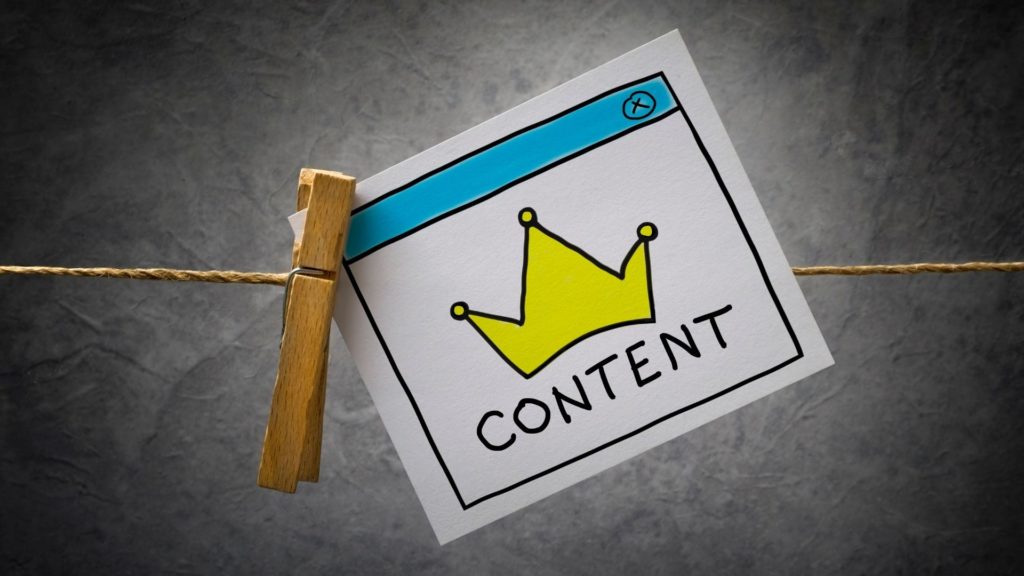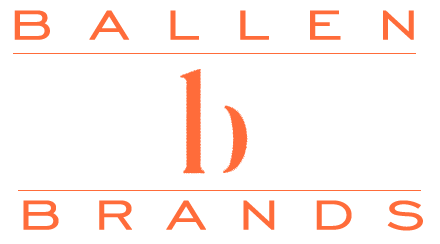Digital marketing is a complicated and complex subject. It’s not as easy as setting up a few social media profiles and sharing your links. Instead, you have to consistently roll out high volume, high-quality content that your viewers will want to consume. To do this, you need a plan for what you’ll publish, where, when, why, and how. Here’s your ultimate content marketing strategy guide.
Schedule A Consultation With Ballen Brands
What is a Content Strategy?
A content strategy is a clear, direct, and written plan for your budget, goals, the kinds of content you’re going to publish, what platforms you’ll use for marketing, who will create the material, and who is responsible for distribution. Then, as an equally important part of the strategy, you track and measure the results of your efforts.

What is Content
Before you can define, create, and implement a content strategy, you first have to fully understand the definition of content.
Content can take the form of:
- Web content
- Articles
- Blog Posts
- Landing pages
- Memes
- GIFS
- Pictures
- Videos
- Podcasts
- Voting polls
- eBooks
- Downloadable offers for lead capture (checklists, workbooks, toolkits, etc.)
There’s print content, too, such as pamphlets and brochures, postcards, letters, newsletters, posters, printed signs, and more.
You’ll combine these tools for best results, creating a diverse mix of entertaining and informative messages for your audience to consume in a calculated, organized, timely fashion.
Focus on your niche when creating content. For example, if you’re a luxury property specialist who works with waterfront homes, it doesn’t make sense to create content about getting an FHA loan. Instead, you might publish a blog about what to look for in a house on the waterfront.
Why Hire Us for Your Website Content and SEO?Find out here! [Ballen Real Estate Websites]
The Value of Content
You can’t just spin up any kind of content, randomly posting here and there when you have the time or inspiration. Instead, think about things your prospects and leads need to solve their problem.
For example, if you’re a real estate agent, you have to post more than properties. If everything you share is a house for sale, people will learn to tune you out. They also won’t feel compelled to follow you on social media if they’re just inundated with ads. Instead, you could create value for home buyers and sellers by publishing articles and blog posts that help with the buying and selling experience, such as:
- How to Buy Your First House
- The Basics of a Home Mortgage Loan
- Closing Costs for Buyers
- Steps to Selling a House
- How to Price Your House for Sale
- How to Prepare for a Home Inspection
- How to Stage Your House

You may also choose to publish monthly market reports for your area and hyperlocal content that features local entertainment, recreation, and resources in your community, such as best restaurants, best parks, things to do, and more.
Pro Tip: Read your blog posts on video for YouTube and then consider converting that video to a podcast for ultimate exposure.
You might also create a series of graphics that include statistics about your local market or quick tips for buying or selling.
Why You Need a Content Marketing Strategy
If you’re in business and trying to generate leads through content, you need a content marketing strategy. Otherwise, you’ll find yourself staring at blank screens, not knowing what to say or where.
You may end up making off-the-cuff posts about flash sales or freebies – or take the bold sales approach, nearly begging customers to bring you their money. Neither are effective approaches.
If you haven’t got keyword strategies for your content, then you’re not optimizing for search engines. Without Search engine optimization, your content is undiscoverable online.

If you’re running PPC (pay-per-click) or social media marketing (SMM) campaigns without a content strategy, then you’re setting yourself up to lose substantial amounts of marketing dollars.
Additionally, if you’re not tracking and measuring before and after your campaigns, you won’t know what’s working and what is probably wasting your time and money.
People want to know they can depend and rely on your content, so it’s vital that you publish high-quality material consistently. Decide whether you’re going to post monthly, weekly, or daily (optimal!) and then stick to it. Your readers will begin to anticipate your next piece of content. However, if you post sporadically with no rhyme or reason, then you’ll lose their attention quickly.
Define Your Brand, Product, and Services
You want to make sure that the content you’re producing has the same flavor, the same energy, and that there’s continuity. To do that, you have to define your brand, its personality, the tone of voice, and the language you’ll use to connect to your audience.
Take the time to write out your brand’s story so that you can incorporate that into your efforts to raise brand awareness.
What is your message?
Tap into your ideal customer’s needs. In other words, what problems will you or your product solve, and how will you do it? You’ll focus more on these points in your content marketing strategy than you will on “selling” something. The goal is to provide value.
Be prepared to state what separates you from the pack. What makes you unique? What is your brand’s value?
Ballen Real Estate Websitesbuilt to resolve common pain points in the real estate industry
The Five Phases of the Customer Journey
There are five stages to a person’s journey through your marketing. The first phase is awareness. Here, you’re introducing yourself to someone who has never heard of you, your product, or your service. Your job in marketing to this individual is to create content that familiarizes them with your brand, mission, and products or service.
The second phase is a consideration. Now that the user is familiar with your brand and what you sell, they’re thinking about whether or not they’ll make the purchase. They haven’t committed yet. They need a tad more convincing. To this person, you’d perhaps publish content with statistics, quick facts, or other persuasive content to help them bond with what you offer.

The third is the decision phase. This is where your content is designed to nudge the user over the line to take action, whether that action is to book an appointment, buy here, register to attend, or other desired outcome. This is the point when the lead becomes a customer.
Fourth is retention. You need to keep the customer you gained satisfied and coming back for more. Repeat business is the goal. You’ll nurture these clients with more tailored content that keeps you on their minds for future reference.
Finally, there’s advocacy – a stage in which you inspire your customer to become an advocate for your brand so that they’re doing your marketing for you by word of mouth, which is the best kind of advertising available. You’ll write content that directs those customers to share, refer, and recommend.

Your content strategy should ultimately include content that is custom designed for each of those phases in your customer’s journey. But you’ve also got to be crystal clear on who your customer is.
One idea is to consider publishing one piece of content per day to cover each of those phases. For example, on Monday, you could focus on brand awareness. Tuesday you could nurture through the consideration phase, Wednesday hit the decision phase, etc. That will fill up a week’s worth of publishing and target each of your leads and clients. Essentially, you’d have five mini content marketing strategies.
Know Your Audience
Your goal is to know everything you can about the person most likely to become a customer. Start by looking at your current clients. How old are they? Are your customers more women than men? What income bracket do they fall in? Are they college graduates? What is their location? What are their interests? The answers to these questions are called demographics.
When you assemble this information in one document, you have a written snapshot of the type of person you need to direct your marketing toward. It’s a picture of your current and future customers.
For example, your customer persona, or customer profile, might be a 36-year-old-woman with a college degree who lives in Florida, makes $50,000 per year, and enjoys shopping at high-end retail stores and reading romance novels.
With that, you can focus on demographic targeting in your content strategy. Rather than trying to reach a worldwide audience with your marketing dollar, you can drill it down directly to the people who are most likely to convert.
What Blogging Can Do for Your BusinessIdentify Your Goals
There are several reasons you’d create a content marketing strategy, but none are as simple as saying, “to get more business.” You might be wanting to:
- Raise brand awareness
- Gain website traffic
- Get social media followers
- Earn social media ratings and reviews
- Capture more email addresses
- Make more sales

Or, you may have a strategy that encompasses all those goals into one comprehensive plan. Outline those goals in great detail so you’ll be able to identify your key performance indicators or KPIs.
Be specific. How many new visitors are you trying to drive to your website? How many social media followers are you trying to gain? How many emails are you fishing for? What’s your magic number in sales?
Know Your Current Stats
Before you can measure your results throughout the campaign, you’ve first got to know your current position. For example:
- How many website visitors do you track each month?
- What is your user engagement like?
- What is your current bounce rate?
- How many leads does your website capture monthly?
- What are your average monthly sales?
- What are your social media stats?
Document these numbers and the date, and then track them throughout your marketing endeavors.
Determine your KPIs, or your key performance indicators, so that you’ll have a clear view of which goals you’re hitting and where you might need a little more attention. How will you know when your marketing efforts are working?
27 Ways to Grow Your Website Traffic OrganicallyResearch the Competition
The best way to determine how to approach your content marketing strategy is to study what your competition is doing, especially the successful businesses. What social media networks are they on? How often do they post? When are new blogs published? Why do users find their content consumable? How are they engaging with their friends, fans, and followers?
You can also use resources like SpyFu.com and SEMrush.com to find out what keywords your competition is ranking for and how much they’re paying for those keywords.

Keyword Research
Keywords are unequivocally the greatest resource you have in your digital marketing toolbox. You need keywords for every single stitch of your content, in any and all of its forms.
Plus, Google rewards companies that tether all of their marketing endeavors together with the same keyword strategy. In other words, the same keyword or keyword phrase would appear in the URL, blog title and content, ads, and landing pages.
A keyword is a word or cluster of words that a person types into a search engine looking for specific information.
What You Need To Know About SEOContent Types & Platforms
Once you’ve checked out what the competition is doing, you’ll have a good idea of what kind of content you’d like to publish. Are you focusing on written content, images and memes, videos, voting polls?
Decide on your topic categories.
For your written content, you’ll need a style guide that talks about length, format, pillar pages, and internal linking so that there’s uniformity in your content and the voice is consistent throughout.

You’ll also need to identify which platforms you’ll use to publish and promote your content. For example, you may start with a WordPress website, but you’ll want to promote the posts from your website through social media. But unless you have a social media manager on your marketing team, you might find it time-consuming and draining to be on all of the networks. Heck, even one network can be difficult to manage for a small business owner whose day is filled with other, more demanding tasks.
It’s not a good practice to post the same thing across multiple platforms at the same time. In the beginning, that might be necessary if you don’t have any existing content. But after a while, if a person follows you across the board and realizes that you’re posting the same thing everywhere, they’re likely to unfollow you on most, if not all, networks. It’s best to mix and match your content so that you’re posting different things each day on each platform.
By identifying your target audience, you should have a good idea about what social media networks your demographic is using. All the social media networks are unique and require different approaches, such as their use of hashtags and post length.
Why Hire Us for Your Website Content and SEO? Find out here! [Ballen Real Estate Websites]Social Media in Content Marketing
Facebook: You can use Facebook in several ways for free and for paid ads. At no cost, you can set up a friend page, a business page and create and join groups, which is an outstanding way to generate leads. For example, a real estate agent might create a Facebook Group for their local service area and feature interesting information, things to do, and engage with the community. When someone in that area is ready to buy or sell a house, that agent’s name will likely come to mind as a valuable resource. You can post on Facebook about two times a day without coming across as pushy.

Instagram: Instagram is a fabulous place to promote your business if your content marketing strategy relies heavily on imagery or if you’re using paid advertising to raise brand awareness or sell products. However, if you’re more interested in sharing links to your blog posts for exposure, Instagram isn’t your best investment of time, energy, or money. Instagram is a slower pace than Facebook, with the ideal number of posts coming in at two or three a week and no more than one post per day.
Twitter: Opposite of Instagram and Facebook, Twitter is a fast-moving machine with posts moving at rapid speeds. It’s easy for them to quickly get buried in the avalanche of information. For this reason, you can post on Twitter up to five times in a single day, which is ideal for recycling older content and engaging with the Twittersphere.
LinkedIn: What separates LinkedIn from the other networks is that it’s a business-to-business platform that’s designed for professionals. You can post up to five times daily, but you’ll need to make sure it’s aimed at other businesses.

YouTube: If you’re using any video at all in your content marketing, then you’ll want a presence on YouTube, the world’s second-largest search engine. You can post videos of any length.
TikTok: TikTok may be all the rave, but it’s definitely geared toward a younger crowd, so if your target market is a 40-something group, then TikTok isn’t worth your time. But if those are your people, then you can produce lots of short, informative videos of about a minute or less. This isn’t a platform where you can drop a link to your blog post and go.
Set and Allocate Your Budget
Many sources suggest that you allocate seven or eight percent of your gross revenue for marketing. Using real estate as an example, the National Association of Realtors® (NAR®) reports that the median gross income for REALTORS® is just about $50,000. At an eight percent investment for marketing, that means you’d spend $4,000 on advertising. You’ll need to carefully determine what dollars get spent on which activities. You may end up needing to hire professionals for the job.
Creating and implementing a complex content marketing strategy isn’t usually a one-person job. You’ll need to allocate portions of your budget for professionals you may need to hire.
Marketing StrategySchedule A Consultation With Ballen Brands
Your Team
You may be able to wear some of the hats and handle portions of the marketing on your own, but you may find it overwhelming, especially as the marketing proves effective and your business starts to grow.
You’re a business owner, but that doesn’t mean you’ve got the education, skill, or desire to become a content strategist, marketing manager, website manager, copywriter, graphic designer, video producer, or social media manager.
Content Strategist: The content strategist is the one who conducts keyword research and investigates the competition to determine what content would be most suitable on your website, its length, as well as when and where it should be published. This is the mastermind behind the project.
Marketing Manager: This person will oversee the entire marketing department and all of its projects, keeping everything on schedule and within budget.

Website manager: The website manager makes sure that content gets transferred to and published on the website and tracks website statistics, such as: new visitors, return visitors, page views, time on page, bounce rate, user engagement, and more.
Copywriter: The copywriter is the talent who takes your broad concepts and keyword strategies and word-weaves them into search engine optimized articles and blog posts. It’s critical that the written content you publish is of high quality, original, and free of errors. Poorly written content and blatant sales pitches can hurt your search engine rankings.
Graphic designer: The graphic designer is the one who will be creating images and graphics to go with your blog posts, in your ads, and for your social media networks. If you’re just starting out, a graphic designer can also help you create your logo, colors, and design.

Video producer: If you’re incorporating video into your content marketing strategy, then you’re going to need someone on hand who knows how to record, produce, and edit video content. Ideally, the copywriter will draft scripts for the videos.
Social media marketer: This is who makes sure that all of your content is cycled through the right channels for the highest visibility. They schedule your blog posts to be posted repeatedly throughout the year, share the images and videos, manage paid ads, and engage with users on each platform. Additionally, your social media marketer will keep track of your page insights and stats, so you’ll know how each network is performing.
You might build your own in-house team, but you can also look for each of these positions to be filled by a freelancer who works as an independent contractor.
Content Publishing Calendar
Your content publishing calendar is your master guide to what is getting published, when, and where. It has categories for all of your social media networks as well as for your blogs.
Once you get the hang of using an automated content publishing calendar like HootSuite.com, SproutSocial.com, or CoSchedule.com, you’ll be able to set your content publishing on autopilot.
You won’t have to wake up in the morning and wonder what you have to post, nor will you have to do it manually. It’ll be done for you. But first, you have to build out the content.
To begin with your content publishing calendar, you’ll need to note the date that the piece will be published. Next, list the topic or headline and the keywords to be used. Write down who the author or creator of the content is. You’ll want to keep track of the article’s status as it moves through the pipeline. Identify the content’s owner, meaning the person who is responsible for seeing that content from idea to completion.
You may break down that master calendar into smaller, task-oriented calendars, but the main content publishing calendar is your master outline for exactly what will happen through the duration of the campaign.
13 Ways to Save Money on Facebook AdsCalls to Action
It’s true that you’re churning out rich content that your viewers can use – articles that answer their questions, videos that give them tutorials, and other content to gain website traffic – the bigger picture is to capture that traffic while they’re on your website. That’s why you’ll include a call to action with every piece of content you publish.

A call to action to capture a lead could be an offer something like a simple downloadable checklist, like a moving checklist for first-time sellers, or something as complex as a several-thousand-word ultimate home seller’s guide. Strategically place that call to action in your article so viewers will click your button to learn more, at which point they’re taken to your landing pages.
This is another project where your writer and a graphic designer will work together to create a professional and polished final product.
Landing Pages
Landing pages are a major element in your online marketing endeavors. When a reader clicks your button to learn more and arrives at your landing page, it’s your job to use that landing page to convince the user to take action, fill out your form, and receive their offer by email.
Your branding and keywords have to be consistent, from your landing pages to your blog posts to your paid ads.
Use a professional writer to craft verbiage that will inspire your website’s viewers. Use a graphic designer to create a visually compelling page. Include social proof like client testimonials.
Choose Your BREW [Ballen Real Estate Websites]Track and Measure Results
It’s essential that you follow your content, tracking and measuring each piece to see how well it performs. You can use resources like Google Analytics, Clicky.com, SEMrush, and others to stay on top of your efforts.
In time, you’ll find patterns. You’ll learn to identify which types of content perform better than others, which times of day or days of the week are best for posting, and with A/B testing, can determine which colors, font styles, and other elements bring in higher yields.
A/B testing is when you run one ad or piece of content, and make changes and run the content again. Change one element to change and run the ad again: the headline, the image, the color, the font style, and you’ll discover what elements perform the best.

Upcycle Old Content
Using the same methods of tracking and measuring for your blog, you’ll be able to identify the blog posts that are getting lots of views vs. those with fewer views or higher bounce rates. This is important for two reasons:
First, you can study the pieces that are popular to find out what’s working. Was it the subject matter? The layout of the content? The style of writing? The keywords? Once you find out what’s doing well, you can emulate that on future blogs.
Second, you have an opportunity to upcycle old content, maximizing its value and visibility. Take a look at a blog post that’s not performing so hot. Compare it to your blog post that is doing well and see how they differ. How can you modify the poorly performing blog post to align more with the style and format of the first?
You can refresh and update old content and republish it as new to keep it in circulation.
How to Use Social Media for Real EstateRinse and Repeat
Creating a content marketing strategy for your business isn’t a one-and-done project. In fact, you’ll create several content marketing strategies over time. You may create an overall strategy for the year, break it down into a monthly strategy, and then task it out weekly.

Monitor the content daily to find out where you can make minor tweaks that could result in major results. Check out your page stats and social media insights to find out when people are most active and engaging with your content. You’ll then have a better idea of when to post in the future.
The Bottom Line
Every small business owner aiming to market their business online needs a content marketing strategy. This strategy details every piece of content that’s being published and what the message of that content is, enforced with well-researched keywords and professional text and design.
Each piece of content has a call to action designed to move your reader through each of the five phases of the sales journey, so they become a lead and then a client and then an ambassador for your brand. Chances are, you’re going to need help along the way as content marketing strategies and their rollout are not usually a one-person show.
Talk with a professional content strategist who can get you started creating a successful content marketing strategy.
Marketing StrategySchedule A Consultation With Ballen Brands
![Ballen Blog _ The Ultimate Content Marketing Strategy Guide [2021]](https://ballenbrands.com/wp-content/uploads/2021/09/the_ultimate_content_marketing_strategy_guide_ballenbrands.png)
